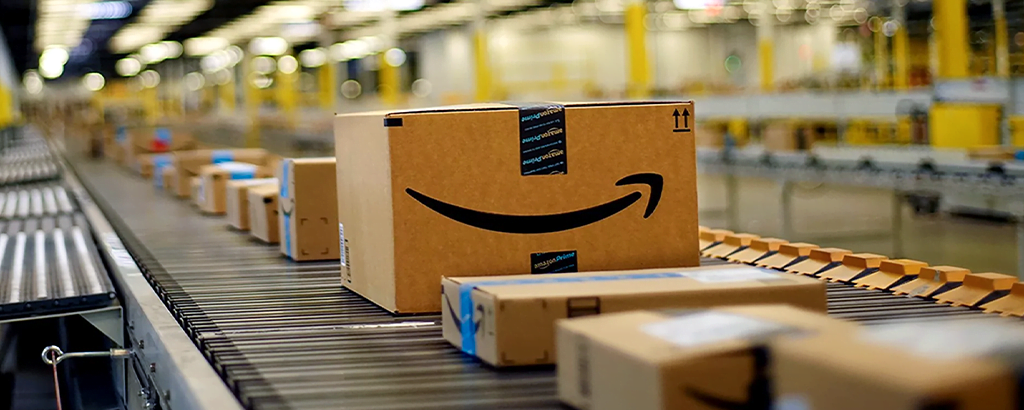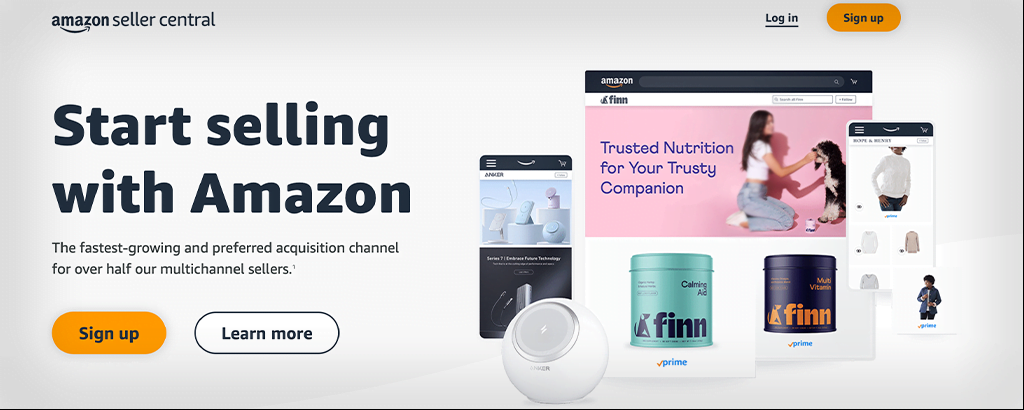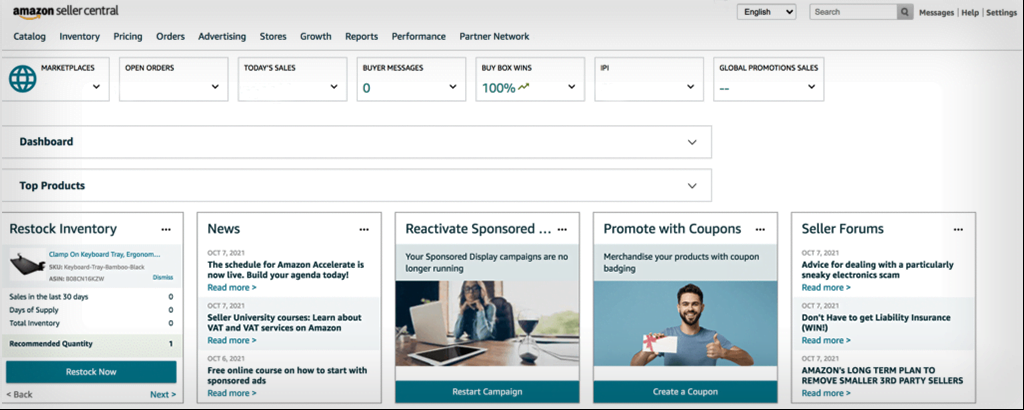Amazon changed how we buy and sell things online. It’s a big platform for businesses and people to sell globally.
Some businesses don’t need to keep physical stuff in stock. This helps more people become entrepreneurs. It might seem tricky, but with good plans, it can work well and make money.
Learn how to sell on Amazon without keeping inventory. This guide has tips and tools for running a successful Amazon business without the usual inventory hassles.
Whether you’re experienced or new to online selling, this guide covers the basics of inventory-free selling on Amazon. Join the exciting journey!
Selling on Amazon without inventory
Selling on Amazon without inventory means you don’t keep the products in stock. When a customer buys, you get the product from another seller who sends it to the customer. It’s like a simplified process:
■ List Products: Put products on Amazon without buying them first, so no upfront costs.
■ Get Orders: When a customer orders, you get the details.
■ Order from Supplier: Buy the product from another seller and give them the customer’s address.
■ Ship to Customer: The other seller sends the product directly to the customer.
■ Handle Service: You deal with customer questions, complaints, and returns.
Selling on Amazon without inventory is appealing because it has low startup costs. Sellers can offer many products without a big initial investment. But it needs careful handling because sellers don’t control the inventory or fulfillment directly. This model depends on trustworthy third-party suppliers.
Basics of Amazon Selling
Selling on Amazon means listing, managing customers, and fulfilling orders on the biggest online marketplace. It’s crucial for businesses as it gives access to a global customer base, allowing them to scale up and increase visibility and profits.

Difference between traditional selling (with inventory) and selling without inventory on Amazon
Traditional selling (with inventory) on Amazon means managing your own inventory. You buy products, store them, list on Amazon, and handle shipping. It needs a big upfront investment and space for storage and order fulfillment.
Selling on Amazon without inventory means no need to buy or store products. Sellers list items they don’t have. When a customer orders, the seller buys from a third-party who ships directly to the customer. It’s called dropshipping.
Third-party fulfillment role in selling without inventory
Third-party fulfillment is key for selling without inventory on Amazon. These services store, pack, and ship products for sellers. Amazon’s FBA is well-known, but other third-party services are also available.
Selling without holding inventory means outsourcing storage and delivery to a third party. Here’s how it works:
Third-party fulfillment services handle logistics, letting sellers operate without physical inventory space. This reduces upfront costs, letting sellers focus on customer service and marketing.
Success depends on the third-party service’s quality. If it’s unreliable or products are poor, it can lead to issues. Choosing a reliable service is crucial for successful inventory-free selling on Amazon.
Summary of the various methods to sell on Amazon
Two ways to sell on Amazon without inventory are dropshipping and using Amazon’s FBA service. Both methods remove the need for sellers to handle physical products, making business easier and cost-effective.

Eliminating the need for inventory in Dropshipping
Dropshipping is a model where sellers don’t keep inventory. When a customer buys, the seller orders from a third-party who ships to the customer. It cuts initial costs and lowers the risk of unsold items.
But it needs careful management. Sellers must work with reliable suppliers for quality and on-time delivery. Keeping track of supplier stock levels is crucial to avoid listing out-of-stock products.
How Amazon handles inventory for sellers in FBA?
Fulfillment by Amazon (FBA) is a way to sell without inventory. Sellers send products to Amazon, and when sold, Amazon handles packing, shipping, and customer service.
It requires upfront product purchase but removes many inventory challenges like storage and shipping. FBA leverages Amazon’s logistics for fast shipping, a plus for customers.
However, sellers should consider FBA costs, including storage and fulfillment fees, in their pricing.
Dropshipping and FBA are profitable ways to sell on Amazon without inventory. The best choice depends on the seller’s budget, goals, and how involved they want to be in fulfillment.
Importance of product selection for Selling
Choosing the right products is very very important when selling on Amazon without inventory.
Product quality, reliability, and manufacturer reputation matter. Select items in demand but not overly saturated. Consider profit margins based on supplier costs and what customers are willing to pay.
Tips to hunt Profitable products to sell on Amazon
Finding profitable products to sell on Amazon involves research and analysis. Here are some strategies:
■ Use Amazon’s Best Sellers List: Check the most popular products in each category for current consumer trends.
■ High-Margin Products: Look for items with low buying costs but high selling prices, ensuring a good profit after Amazon’s fees.
■ Consider Size and Weight: Smaller, lighter products are often cheaper to ship, increasing profit margins.
■ Analyze Trends: Use tools like Google Trends to spot products gaining popularity.
■ Research Competition: See what successful sellers in your niche are offering.
Amazon’s product restrictions and policies
Amazon doesn’t let you sell certain things, and some need permission, like specific electronics or branded items. Things like dangerous goods are not allowed. You have to give correct info about your products, following the rules.
If you don’t follow Amazon’s rules, they might stop you from selling. It’s important to know these rules to avoid problems and make selling easy.

Easy way to open your Amazon seller account
Creating your Amazon Seller Account is the first step to sell on this big online store. Whether you choose dropshipping or Amazon’s FBA service, this account is your way to reach millions of customers globally.
It’s like the backbone of your Amazon business, helping with transactions, talking to customers, and most importantly, listing your products.
Set up an Amazon seller account in easy steps
Creating an Amazon seller account to sell items is a simple process. Here are the steps:
■ Visit Amazon’s Services Website: Click “Start Selling” on Amazon’s services website.
■ Choose Your Account Type: Select “Individual” (no monthly fee but $0.99 per item) or “Professional” ($39.99 monthly fee, no per-item fees).
■ Provide Business Info: Fill in your legal name, address, and phone number.
■ Set Up Billing/Deposit: Give a credit card for fees and a bank account for sales proceeds.
■ Register for Taxes: Fill in tax info following Amazon’s steps.
■ Create Your Storefront: Pick your store name and set up your Amazon storefront.
■ List Your Products: Start listing products for sale, especially if you’re selling without inventory using third-party suppliers.
Offer outstanding customer service
Providing good customer service is vital for any business on Amazon, even for those without inventory. Your main contact with customers is through customer service, making it a essential part of their experience.
Quality customer service can result in happier customers, positive reviews, and repeat business. Yet, selling without inventory has its challenges, relying on third-party suppliers for product quality and delivery.
To uphold high customer service standards, it’s essential to choose reliable suppliers, communicate transparently, and promptly address customer issues.
Role of customer service on Amazon
When you’re not physically handling products, customer service becomes a vital way to connect with customers and shape their experience.
Good customer service builds trust, boosts satisfaction, and encourages repeat business. On the flip side, poor service can result in negative reviews, harm your seller reputation, and impact sales.
Selling without inventory may bring issues like delayed shipping or product quality problems, often linked to third-party suppliers’ errors. Swift and effective communication can resolve these issues and keep customers satisfied.
Tips for Providing high customer service
Even if others handle your products, making customers happy is still your job. Good customer service is super important for success on Amazon. Here’s how to do it if you don’t keep your own stuff:
■ Pick Good Suppliers: Choose suppliers who send good stuff on time to avoid problems.
■ Talk Often: Keep talking to your suppliers to fix any possible issues for your customers.
■ Answer Fast: Answer customer questions quickly to show you want to help.
■ Be Honest: If something’s wrong with an order, tell the customer right away. Being honest helps keep their trust.
■ Train Your Team: If you have a team, teach them how to help customers and be really good at it.
■ Check Reviews: Read what customers say to find problems and ways to make things better.
■ Easy Returns: Make it easy for customers to return stuff they don’t like with a fair policy.
Optimize & Manage your sales
Running Amazon sales needs ongoing attention. Keep an eye on your sales, update product listings, and use strategies to boost sales. The aim is to be seen more, increase conversions, and, in the end, make more money.

Regular management of your Amazon seller account
Regularly managing and optimizing your Amazon seller account is crucial. It helps you track sales, spot issues, and find growth opportunities. This ongoing optimization boosts your product listings’ visibility, attracting more clicks and sales.
Since Amazon is always changing, with customer trends and competitor actions shifting, regular account management lets you adapt. This might mean updating listings, tweaking prices, or changing marketing strategies.
Tips for tracking and increasing sales
To boost profits, you need a toolkit with various software to guide you. Here are key tools:
■ Amazon Seller Central Reports: Track sales, returns, and overall performance with Amazon’s detailed reports.
■ Keyword Tools: Tools like Jungle Scout, Helium 10, or Amazon’s keyword tool find top-performing keywords, improving visibility.
■ Pricing Tools: Use tools like RepricerExpress to adjust prices based on competitors, maximizing sales and profits.
■ Quality Product Listings: Ensure listings have clear images, detailed descriptions, and relevant keywords.
■ Amazon Advertising: Boost product visibility and attract more traffic using Amazon’s advertising options.
■ Customer Reviews: Encourage positive reviews to influence potential customers and increase sales.
■ Inventory Management Tools: For dropshipping, use tools to track supplier stock and avoid listing out-of-stock products.
■ Multichannel Sales Reports: Software like Synder provides instant reports on sales metrics across platforms.
Conclusion
Selling on Amazon without inventory is a unique e-commerce model, avoiding traditional inventory challenges. Understand Amazon basics, choose the right products, set up a seller account, give great customer service, and manage sales for a successful business.
This model is profitable and scalable. Using dropshipping or Amazon’s FBA, you serve diverse customers without physical inventory. It cuts upfront costs and allows easy business scaling with more products or new markets.
For an e-commerce start, Amazon offers a strong platform to reach global customers. With the right approach, build a successful business on Amazon without holding inventory.

